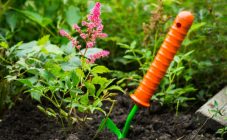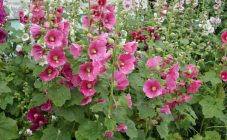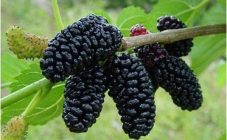Content:
Due to its long flowering and high decorative properties, begonia attracts both experienced and novice growers. It can be grown in open ground conditions, as well as in residential premises. In most cases, it is used to plant greenery on loggias and balconies, to decorate the front entrances to administrative buildings. Florists grow culture in their summer cottages, decorate gazebos, creating a unique design.
The flower in the apartment looks very impressive, as it can decorate almost any interior. Due to the varied and rich color palette, as well as various forms, it can be easily combined with other types of plants.
How to breed begonias: differences in home and outdoor care
As for the varieties, they can be both perennial and annual. You can also find plants with a tuberous or creeping root system, with fruits that are in a capsule. It is worth noting that in order to achieve lush and long flowering, in the process of growing begonias, it is necessary to pay due attention to it.
The rules for breeding and caring for begonias in the open field and in indoor conditions are significantly different. In order to grow this culture in an apartment, you need to ask yourself how to breed begonia and follow these recommendations:
- to the maximum create favorable conditions that will promote flowering and active growth of begonias;
- protect the plant from wind and frequent drafts;
- create optimal environmental conditions in the winter season;
- choose a suitable location for the location so that the culture feels comfortable all year round.
It is worth noting that you need to care for begonias one month before the planned planting of tubers in open ground. It is necessary to wait until the emerging seedlings grow a little, and then take them out to the street for hardening. The time away from home should be gradually increased. As soon as the ground warms up to at least 15 degrees Celsius, the seedlings must be planted in the garden.
How begonia reproduces
Many novice growers are wondering how to propagate begonia. To date, breeders have bred about 1200 varieties of crops, as well as hybrids that differ in the shade of inflorescences and the shape of the shrub. For growing outdoors, tuberous begonias are mostly intended. Popular varieties are Begonia Eternal Blossoms and Pendula.
Unlike plants, the flowering of which begins with the arrival of spring, begonia will serve as an adornment of the personal plot during the autumn season. Reproduction of garden culture is provided in the following ways:
- by the seed method;
- cuttings;
- tuberous method;
- with the help of leaflets.
Even though begonia is a light-loving flower, it is recommended to plant it in shaded areas, because direct sunlight can negatively affect the further development of the plant.To avoid excessive drying out of the soil near the begonia, it must be watered abundantly and regularly.
Cutting begonias: how to prepare planting material
Before you start propagating begonias by cuttings, they need to be prepared. For this procedure, it is recommended to select only healthy and strong cuttings, the length of which is at least 12 cm. Cut the stems with a sharp knife or razor under the knot - the place from which the foliage grows.
If you want to get several plants at once, whole stems can be divided into several equivalent parts. But you need to remember that each part must have at least two buds. It is imperative to remove excess buds and flowers, as well as foliage from the cuttings. And only at the top you can leave 1-2 leaves.
Leaves that are large in size should be cut in half. As for the removal of buds, leaves and flowers, this is necessary so that they do not take nutrients from the culture and allow it to fully develop. Tuberous begonia, in contrast to ever-flowering, should be in a state of complete rest for a certain period of time. As soon as daylight hours are reduced, begonia foliage dries up, and an increase in the duration of daylight time entails the appearance of new shoots that can be used as planting material.
How to root a begonia with a handle in water
Reproduction and cultivation of begonias by cuttings in water, provided that certain rules are followed, does not present any difficulties even for novice florists. Before lowering the cuttings into a container of water, they must be soaked in a growth stimulator (for example, Zirkone or Gumisol-N). This procedure will contribute to rapid rooting, especially in cases where weakened stems are used as planting material.
It is worth noting that begonia is very demanding on the capacity in which it will take root. It will be effective to multiply the culture in containers made of dark glass, as it can block the sun's rays, allowing the water to stay fresh longer. Experienced flower growers know how to cut begonia, and they strongly discourage changing the water during rooting, but only adding a small amount of fresh liquid.
When breeding and growing royal begonias, it is necessary to use the softest (filtered, rain or settled) water. Experienced growers advise adding a little freshly squeezed aloe juice to the water, which acts as a powerful natural growth stimulant. The substance helps to strengthen the immune system of the culture, and also protects the plant from damage by phytopathogens. Add 5 drops of aloe juice to 200 ml of water. As for the step-by-step process of rooting and further transplantation into the ground, the algorithm is as follows:
- Begonia leaf propagation provides for the creation of a certain temperature regime (no more than 22 degrees above zero). The container with cuttings should be placed in a dark place where direct sunlight does not penetrate, but at the same time it should be well lit.
- If rot is noticed on the stems, the cuttings must be pulled out, and the affected areas must be cut with a knife.After that, the cuttings must be dried, and then placed in a container, in which the water must first be changed.
- In young begonias, which were obtained as a result of propagation by cuttings in water, a root system is formed rather quickly, the length of which, at the initial stage of formation, is about 2 cm.
- After rooting, young plants should be immediately transplanted into a special soil designed for begonias.
Recommendations for further begonia care
Before wondering how to propagate begonia with a leaf or cuttings, a novice florist should definitely familiarize himself with some recommendations regarding plant care. Cutting and growing crops provides for regular ventilation of begonias, as well as moistening the soil with a spray bottle. With the appearance of the first shoots, it is necessary to gradually increase the airing time, so that the begonia has passed adaptation and got used to the air.
If the night is relatively warm and cloudy, the window in the room where the cuttings are located can be opened. If you follow the advice of experienced florists, you can transplant young seedlings into separate containers in an extremely fast time. It is also worth noting that rooting of begonias with the help of leaves should be carried out in the second half of spring or early summer, but always at a temperature of no more than 30 degrees Celsius.
Begonia can very often be affected by diseases and pests such as spider mites and aphids. It is recommended to treat the culture and fight parasites with the help of an infusion prepared according to a recipe from garlic or onion peels, which must be periodically sprayed with the plant. To avoid the reappearance of pests, the begonia should be treated with wood ash, previously diluted in water.
With careful observance of all recommendations, the cultivation and reproduction of begonias will certainly lead to the desired result, and a beautiful flowering plant will become a real pearl of a garden plot or living quarters.

















